Preservation Advocacy in Washington, DC
Last fall, there was a "defeat" in the creation of an historic district in the greater Tenleytown area. I learned about this from the H-DC email list, which linked to the website of the historic designation opponents. Given that tomorrow there is a meeting about the Comprehensive Plan and historic preservation, it's worth putting up my response to this from last fall.
_________
It is very frustrating that preservation advocates, and I include myself among them, don't seem to do a very good job about explaining the value of historic preservation in the city. It is just as frustrating that residents fail to see what ought to be hitting them in the head, that architectural distinctiveness and history are the defining characteristics of the City of Washington, providing us with a unique sense of place, which makes our city worth living in, and are the source of the city's "unique selling proposition" that makes it attractive to others.
Personally, I feel that the city government isn't really committed to preservation either, by and large seeing it as a hindrance. Merely a handful of City Councilmembers seem to be committed to preservation, and some seem quick to attack preservation if it means pandering to their constituents.
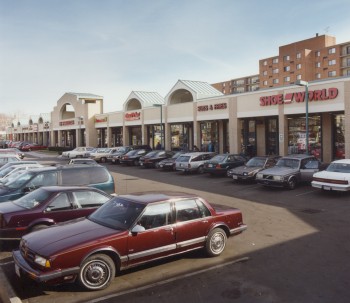 Your tax dollars at work--urban-renewal-based economic development in Northeast Washington, DC.
Your tax dollars at work--urban-renewal-based economic development in Northeast Washington, DC.The Tenleytown Fire Station is a case in point. That fiasco had everything to do with the fact that the Fire Department seemed to be over its head in terms of its skill in construction contracting, and the choice of the lowest bidder despite the fact that this bidder had experienced problems on previous construction projects, and little if anyhing to do, fundamentally, with historic preservation. Nonetheless, Kathy Patterson put forth a bill to gut historic preservation protections for "public safety facilities" even though the Department of Defense and other municipalities such as NYC seem to manage just fine in having facilities being regulated by relevant federal or local historic preservation laws.
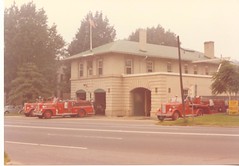 Engine House 20 in more historic times.
Engine House 20 in more historic times.This failure to explain and lack of commitment to preservation is doubly ironic though, because the only reason the city weathered 30-40 years of disinvestment, outmigration and a serious decline in population is because of the existence of historic residential building stock, which attracted a wide variety of people willing to live in great buildings, despite the serious decline in the provision of quality municipal services in all ways, shapes, and forms, that accompanied the decline in population.
That's why some of the statements in the anti-historic preservation website referenced are so laughable. I can't imagine there exists one historic district across the United States where because of designation "The resale value of your home could decline" as is stated. I refer people to Donovan Rypkema's paper "The Economic Power of Historic Preservation" for a much more thorough discussion of this issue. The general point about designation is that it reduces risk and increases value because of the baseline of quality created by design review, etc.
The reason that I have become such a "zealot" for preservation is that time and time again it is proven that substantive, sustainable, and successful center city revitalization results only from activities that are preservation-based. (See for example, The Living City and Cities: Back from the Edge both by Roberta Gratz, or Changing Places by Richard Moe and Carter Wilkie. For a discussion of this with regard to "community development" which typically has been urban clearance and renewal based, see Organizing for Community Controlled Development by Patricia Murphy and James Cunningham.)
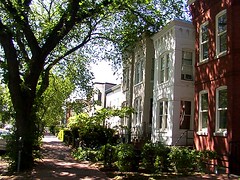 Rowhouses on Capitol Hill.
Rowhouses on Capitol Hill.The anti-designation website seriously mis-states the process for creating historic districts, and these arguments are too frequently repeated (such as the recent discussion over the expansion of the Dupont Circle Historic District). It is impossible for a "secretive" band of neighbors to create an historic district without anyone knowing about it. There is a specific process required that includes notice to impacted property owners.
Note: requirements for creating historic districts are much more difficult today, including the documentation of every building, which was not the case when many of the historic districts in the city were created years ago, i.e., Le Droit Park, Anacostia, and Capitol Hill historic districts.
The increased requirements (before only a sampling of buildings needed to be researched) are complicated by the fact that the federal Historic Preservation Fund, which funds survey efforts, is woefully underfunded, plus the city can (and does) use this money for non-survey activity, which makes it difficult to undertake survey efforts because of the cost and time involved in conducting the research. Figure on a minimum of ten hours/building, plus photography, and the research and writing of a neighborhood history, and you get some idea of how daunting a process this can be. (Now that the Historic Preservation Office is automating building permit data, the amount of time required to document each building in a proposed historic district is significantly reduced.)
There are organizations in other parts of the country that to my mind do amuch better job in explaining the value of historic preservation than we do in DC. First, the Community Design Center of Pittsburgh, in their "Homeowner Resources Section" has some incredible slide shows that demonstrate how people can do "good jobs" or "bad jobs" in renovating, and the kind of impact this has on their neighbors, as well as the value of their home. They publish five 2-page documents on "Your Home," "Your Roof," "Your Windows," "Your Walls," and "Your Porch" because "Anything you do to the outside of your home affects not only the value and character of your own house, but also the entire neighborhood." (The pdf documents are not the highest quality though.)
Certainly, those of you who live in neighborhoods like mine, where people tear off porches, install inappropriate windows, take out tin ceilings, take the wooden clapboards off houses and replace the facade with brick, build cinder block additions, or truck in prefabricated execrable buildings and plop them in as infill across the street from 1880s-1890s Victorian brick buildings understand this full well. In this vein, CDCP needs to add a "Your Door" piece--aren't we all sick of seeing these Home Depot doors with their fake stained glass populating more and more houses in undesignated but eligible neighborhoods?
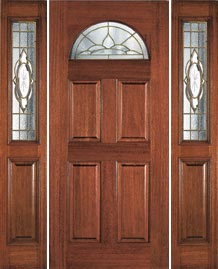 This "fan light" door, much nicer than the average store-bought door used by renovators in DC, is by and large not an historically accurate choice for DC homeowners.
This "fan light" door, much nicer than the average store-bought door used by renovators in DC, is by and large not an historically accurate choice for DC homeowners.Second, the Landmark Society of Western New York publishes a great book called Rehab Rochester which discusses historic house architecture as well as how to take care of your house in architecturally appropriate ways. If you think of the historic building stock we have in the city as the architectural legacy that is left to us in stewardship for the future, a book like this is important in explaining why our historic buildings and neighborhoods matter (which is especially important because people still have a hard time thinking of "everyday" neighborhoods as historic in comparison to buildings and places that are sites of important historic events and people--such as Mt. Vernon, the home of George Washington).
This book is comparable to books published by other preservation organizations and even to LeDroit Park Conserved and Anacostia Conserved which were produced under the guidance of the great urban design critic, professor, and practitioner Kevin Lynch. The handbooks, published in 1979 by DHCD and are lamentably out of print, but are available at Washingtoniana and probably the City Museum research library.
Third, the State of Ohio Historic Preservation Office has a great, great, great program called "The Building Doctor" which is a two-part program. The first part explains the relevant history of architecture, preservation, the Secretary of Interior's Standards for the Treatment of Historic Properties, renovation, etc., and the second part is "field-based" where preservation staff go out and assess particular houses and/or commercial structures. Recognize that this program goes all across the state of Ohio, so it's a bit different than we'd need for our 67 square mile city.
The reason that I like this program so much is like the others referenced above, it explains why historic preservation matters, using both architectural history and community history to explain these issues. The Old Building Owners Manual and Caring for Your Old House companion books to this program are available for purchase.
Last fall, I attended the National Trust for Historic Preservation annual meeting, and two of the workshops I attended stressed the necessity of sussing out the themes and stories of your house museum/historic site/heritage area/historic district.
I love the buildings, but it's the stories that resonate with people. And I think we need to do a better job as preservationists in explaining these stories as well as combining the stories, history, and the economic and preservation of neighborhood character and architectural distinctiveness into successful arguments in favor of historic preservation throughout the city.
In fairness to us preservation advocates, who toil away often with little support and in face of organized opposition (note that in areas facing serious development pressures, opposition is fomented and/or organized by development interests, the pro-development land use bar, community development corporations, and other folk), it is difficult to argue in favor of saving "old buildings" in a society that reveres the new, and the prevalent attitude that "new" means "improved" and that suburbanization of the center city is the best course of action for revitalization. James Kunstler explains all this far better than I ever could, in Home from Nowhere and Geography of Nowhere.
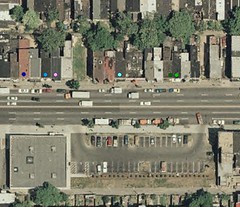 On the top of this aerial photo of the 1200 block of H Street, buildings eligible for historic designation are visible, while on the south side, such buildings were torn down, to be replaced by a cinder-block Autozone store and parking lot.
On the top of this aerial photo of the 1200 block of H Street, buildings eligible for historic designation are visible, while on the south side, such buildings were torn down, to be replaced by a cinder-block Autozone store and parking lot.Similarly, I find it incredible that after 43 years, the precepts laid out by Jane Jacobs in Death and Life of Great American Cities are still studiously ignored and/or explained away by professionals and government officials that should know better. Frankly, in these campaigns to get "everyone" in a city to read the same book, I think we should read Death and Life or Gratz's Cities: Back from the Edge just so that all caring citizens of this great city could begin to operate from the same place in consideration of fundamental development issues that face all of us as concerned residents of the City of Washington, the baseball stadium being a case in point.
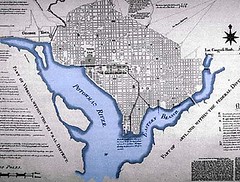 A good read for today, again by Donovan Rypkema, is "Planning the Future, Using the Past: The Role of Historic Preservation in Building Tomorrow's Washington, DC" . (Another great paper by Rypkema is "Affordable Housing and Historic Preservation: The Missed Connection".
A good read for today, again by Donovan Rypkema, is "Planning the Future, Using the Past: The Role of Historic Preservation in Building Tomorrow's Washington, DC" . (Another great paper by Rypkema is "Affordable Housing and Historic Preservation: The Missed Connection".In our city, it all starts with L'Enfant.



0 Comments:
Post a Comment
<< Home